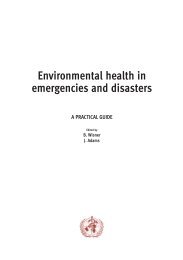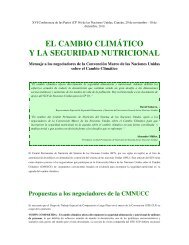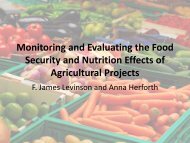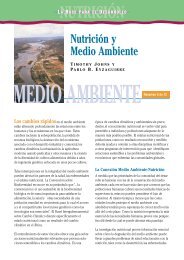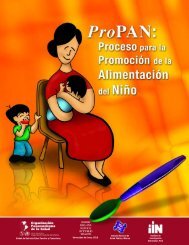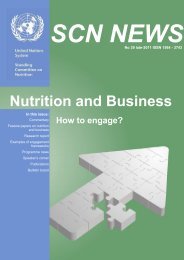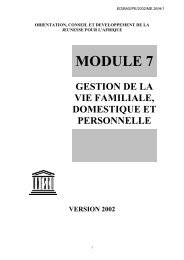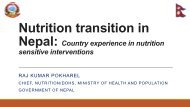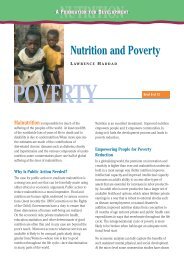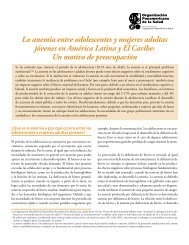SCN News No 36 - UNSCN
SCN News No 36 - UNSCN
SCN News No 36 - UNSCN
You also want an ePaper? Increase the reach of your titles
YUMPU automatically turns print PDFs into web optimized ePapers that Google loves.
52<br />
35 TH <strong>SCN</strong> SESSION RECOMMENDATIONS www.unsystem.org/scn<br />
RECOMMENDATIONS OF THE 35 TH SESSION OF THE <strong>SCN</strong> IN HANOI MARCH 2008<br />
Introduction<br />
The 35 th Session of the <strong>SCN</strong> in Hanoi focused on the theme: Accelerating the reduction of maternal and child undernutrition.<br />
Discussions of this issue of central concern of the <strong>SCN</strong>, took advantage of new analysis and suggestions coming from<br />
the recent Lancet Nutrition Series. 1 An additional consideration was the recognition that the realization of the right to adequate<br />
food 2 , to health 3 and to other human rights relevant to the attainment of good nutrition 4 , are essential to achieve the<br />
aims of the Millennium Declaration 5 , including those expressed by the Millennium Development Goals 6 .<br />
Recognizing that:<br />
1. The global burden of maternal and child undernutrition remains unconscionably large, and is the single greatest constraint<br />
facing global development efforts.<br />
• Maternal and child undernutrition is the underlying cause of at least 3.5 million deaths each year, 35% of the disease burden<br />
in children younger than 5 years of age, and 11% of the total global disease burden.<br />
• 138 million children under five (32%) are stunted and 18 million are severely wasted. Furthermore 13 million babies are<br />
born each year with Intrauterine Growth Restriction (IUGR). Together these conditions constitute a quarter of the risk<br />
of death and disease burden, the largest risk in this age group.<br />
• Suboptimal breastfeeding, especially non-exclusive breastfeeding in the first six months of life, results in 1.4 million<br />
deaths each year and 10% of the disease burden in children younger than 5 years.<br />
• Iron deficiency anaemia accounts for at least 20% of maternal mortality.<br />
• Progress towards the non-income targets of the first Millennium Development Goal (MDG1) is still far from adequate.<br />
Despite remarkable economic growth in many countries during the last two decades, the prevalence of child underweight<br />
has declined at only sixty percent of the rate needed to achieve the MDG1 non-income target globally.<br />
• Lack of progress in tackling maternal and child undernutrition not only impacts on the non-income targets of MDG1,<br />
but also on maternal and child mortality (MDG 4 and MDG 5). Furthermore stunting leads to irreversible damage later<br />
in the course of life, including lowered attained schooling (MDG2) and decreased earnings.<br />
2. A deeper understanding of the implications of stunting and wasting has emerged which the measure of underweight<br />
alone does not capture. This understanding provides important insights into how and when to tackle the problem of maternal<br />
and child undernutrition.<br />
• Stunting, or length growth faltering, is as much a reflection of poor maternal nutrition as it is of poor infant and young<br />
child feeding. 7<br />
• The process of stunting is largely over by two years of age, providing a new "window of opportunity" for delivery of<br />
nutrition interventions from conception to two years of age. 8<br />
•<br />
Advances in the treatment of severe acute malnutrition mean that severely wasted children without medical complications can<br />
be effectively treated with ready to use therapeutic foods (RUTF) in the community with much reduced case fatality rates. 9<br />
• Accelerated weight growth after two to three years of age in children that are stunted but not wasted increases the likelihood<br />
of nutrition related chronic disease (obesity, diabetes, high blood pressure) later in life. 10<br />
3. A renewed and strengthened evidence base exists for a set of essential nutrition interventions 11 that if effectively targeted<br />
at mothers and children from conception to two years of age, could prevent at least a quarter of child deaths under <strong>36</strong><br />
months of age, and reduce the prevalence of stunting by about a third. These preventive and curative interventions are mutually<br />
reinforcing elements of an effective response. They must be integrated in a comprehensive approach, including:<br />
• Infant and young child feeding 12 (promotion of early and exclusive breastfeeding through individual and group counselling<br />
13 ; behaviour change communication for improved complementary feeding 14 and continued breastfeeding)<br />
• Micronutrients (iron/folate 15 or multiple micronutrient 16 , and calcium supplements for mothers during pregnancy and<br />
lactation, fortification of complementary foods 17 , fortification of salt with iodine 18 , zinc supplementation in the management<br />
of diarrhoea in young children 19 , vitamin A fortification and/or supplementation 20 );<br />
• Treatment of severe acute malnutrition using special therapeutic foods 21 (linked community and facility based treatment),<br />
along with anti-retroviral drugs for HIV/AIDS.<br />
• Context specific interventions 22 :<br />
• in areas of food insecurity 23 (maternal food supplements that are balanced in energy and protein 24 , complementary food<br />
supplements for children 6-24 months 25 especially if through conditional cash transfer 26 with nutritional education).<br />
• in malaria areas 27 (presumptive treatment during pregnancy, insecticide treated bed nets);<br />
• in areas with high loads of gastrointestinal parasites 28 (deworming in pregnancy as well as in infancy and early child<br />
hood, hand washing and hygiene 29 ).<br />
4. Although this important set of interventions cannot replace socio-economic development, they can accelerate reduction of<br />
maternal and child undernutrition, especially when delivered as part of such efforts. Improved maternal and child nutrition is<br />
not an automatic by-product of poverty reduction and economic advance 30 . Therefore this set of essential nutrition interventions<br />
must be added "on top" and mainstreamed into national poverty reduction strategies 31 through various sectors including:<br />
efforts aimed at strengthening household food security; conditional cash transfer programmes and other social security<br />
safety nets; efforts aimed at strengthening health services, including those aimed at ensuring a continuum of maternal 32 ,




